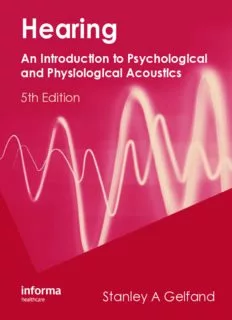
Hearing: An introduction to psychological and physiological acoustics PDF
Preview Hearing: An introduction to psychological and physiological acoustics
Hearing Hearing: An Introduction to Psychological G and Physiological Acoustics e l f 5th edition a n About the book d An Introduction to Psychological Hearing science is an exciting area of study due to its dynamic, broad and interdisciplinary scope. This new edition has been updated and expanded, and provides the reader a friendly and Physiological Acoustics unified approach to the anatomical, physiological, and perceptual aspects of audition. Hearing, 5th edition will provide graduate students in audiology and hearing science with an integrated introduction to the sciences of hearing, as well as provide an overview of the field H for the more experienced reader. Practicing audiologists, psychologists, speech-language pathologists, physicians, deaf educators, industrial hygienists, and engineers, will also find e 5th Edition this as a useful reference. a Table of contents r i Physical Concepts • Anatomy • Conductive Mechanism • Cochlear Mechanisms and n Processes • Auditory Nerve • Auditory Pathways • Psychoacoustic Methods • Theory g of Signal Detection • Auditory Sensitivity • Masking • Loudness • Pitch • Binaural and Spatial Hearing • Speech and its Perception About the author 5 Stanley A Gelfand PhD is Professor at the Department of Linguistics and Communication t h Disorders, Queens College of the City University of New York, Flushing, NY, as well as the PhD Program in Speech-Language-Hearing Sciences, and the AuD Program, Graduate School of the E City University of New York, USA. Previously, Professor Gelfand served as Chief of the Audiology d and Speech Pathology Service, Veterans Administration Medical Center, East Orange, New Jersey, i t USA, and Clinical Professor, Department of Neurosciences, New Jersey Medical School, University i o of Medicine and Dentistry of New Jersey, Newark, USA. He has authored numerous publications n on a wide range of topics including acoustic immitance, speech perception, hearing aids, auditory deprivation, and reverberation, including Essentials of Audiology, now in its third edition. Professor Gelfand is a Fellow of the American Speech-Language-Hearing Association and the American Academy of Audiology, and a member of the Acoustical Society of America and the American Auditory Society. He received his BA and MA degrees from the City College of New York, USA, and his PhD degree from the City University of New York, USA. Telephone House, 69-77 Paul Street, London EC2A 4LQ, UK 52 Vanderbilt Avenue, New York, NY 10017, USA Stanley A Gelfand www.informahealthcare.com SPH SPH IHBK034-FM IHBK034-Gelfand November12,2009 19:21 CharCount= Hearing: An Introduction to Psychological and Physiological Acoustics 5th Edition Stanley A. Gelfand DepartmentofLinguisticsandCommunicationDisorders QueensCollegeoftheCityUniversityofNewYork Flushing,NewYork Ph.D.PrograminSpeech-Language-HearingSciences,andAu.D.Program GraduateSchooloftheCityUniversityofNewYork NewYork,NewYork,USA SPH SPH IHBK034-FM IHBK034-Gelfand November12,2009 19:21 CharCount= (cid:1)C 2010InformaUK Firstpublishedin2010byInformaHealthcare,TelephoneHouse,69-77PaulStreet,LondonEC2A4LQ.Informa HealthcareisatradingdivisionofInformaUKLtd.RegisteredOffice:37/41MortimerStreet,LondonW1T3JH. RegisteredinEnglandandWalesnumber1072954. Allrightsreserved.Nopartofthispublicationmaybereproduced,storedinaretrievalsystem,ortransmitted,inany formorbyanymeans,electronic,mechanical,photocopying,recording,orotherwise,withoutthepriorpermission ofthepublisherorinaccordancewiththeprovisionsoftheCopyright,DesignsandPatentsAct1988orunderthe termsofanylicencepermittinglimitedcopyingissuedbytheCopyrightLicensingAgency,90TottenhamCourt Road,LondonW1P0LP. Althougheveryefforthasbeenmadetoensurethatallownersofcopyrightmaterialhavebeenacknowledgedin thispublication,wewouldbegladtoacknowledgeinsubsequentreprintsoreditionsanyomissionsbroughttoour attention. ACIPrecordforthisbookisavailablefromtheBritishLibrary. LibraryofCongressCataloging-in-PublicationData Dataavailableonapplication ISBN-13:978-1-4200-8865-6(Hardcover) Ordersintherestoftheworld InformaHealthcare SheepenPlace Colchester EssexCO33LP UK Telephone:+44(0)2070175540 Email:[email protected] TypesetbyAptara(cid:1)R,Inc. PrintedandboundinGreatBritainbyCPI,AntonyRowe,Chippenham,Wiltshire SPH SPH IHBK034-FM IHBK034-Gelfand November12,2009 19:21 CharCount= ToJanice InLovingMemory SPH SPH IHBK034-FM IHBK034-Gelfand November12,2009 19:21 CharCount= SPH SPH IHBK034-FM IHBK034-Gelfand November12,2009 19:21 CharCount= Contents Preface .... vii 1. PhysicalConcepts 1 2. Anatomy 20 3. ConductiveMechanism 51 4. CochlearMechanismsandProcesses 72 5. AuditoryNerve 103 6. AuditoryPathways 122 7. PsychoacousticMethods 146 8. TheoryofSignalDetection 160 9. AuditorySensitivity 166 10. Masking 187 11. Loudness 207 12. Pitch 218 13. BinauralandSpatialHearing 231 14. SpeechandItsPerception 257 AuthorIndex .... 282 SubjectIndex .... 301 v SPH SPH IHBK034-FM IHBK034-Gelfand November12,2009 19:21 CharCount= SPH SPH IHBK034-FM IHBK034-Gelfand November12,2009 19:21 CharCount= Preface Thisisthefiftheditionofatextbookintendedtoprovidebegin- likely that this book might be used as a core text for a two- ning graduate students with an introduction to the sciences coursesequencedealingwithpsychologicalandphysiological of hearing, as well as to provide an overview of the field for acoustics,alongwithappropriatelyselectedreadingsfromthe moreexperiencedreaders.Theneedforacurrenttexthasbeen researchliteratureandstate-of-the-artbooks.Suggestedread- expandedbytheadventandwideacceptanceoftheprofessional ingsareprovidedincontextthroughoutthetexttoprovidea doctorateinaudiology,theAu.D.However,aninterestinhear- firmfoundationforfurtherstudy. ingisbynomeanslimitedtoaudiologistsandincludesreaders Mysincerestthanksareexpressedtothenumerouscol- withwidelydiverseacademicbackgrounds.Amongthemone leaguesandstudentswhoprovidedmewithvaluablesugges- finds psychologists, speech-language pathologists, physicians, tionsthathavebeenincorporatedintothisandprioreditions. deafeducators,industrialhygienists,andengineers,amongoth- Iamespeciallyindebtedtomycurrentandformercolleagues ers.Theresultisafrustratingdilemmainwhichatextwilllikely and students in the Department of Linguistics and Commu- betoobasicforsomeofitsintendedreadersandtooadvanced nication Disorders at Queens College, the Ph.D. Program in for others. Thus, the idea is to provide a volume sufficiently Speech-Language-HearingSciencesandtheAu.D.Programat detailedtoserveasacoretextforgraduatestudentswithapri- theCityUniversity ofNew YorkGraduate Center,andat the maryinterestinhearing,atthesametimeavoidingareliance EastOrangeVeteransAffairsMedicalCenter.Thankyouallfor onscientificormathematicalbackgroundsnotsharedbythose beingcontinuousexamplesofexcellenceandforyourvalued withdifferentkindsofacademicexperiences. friendships.Iamalsogratefultothetalentedanddedicatedstaff Hearingscienceisanexcitingareaofstudybecauseofits ofInformaHealthcare,whocontributedsomuchtothisbook broad,interdisciplinaryscope,andevenmorebecauseitisvital andgraciouslyarrangedforthepreparationoftheindicesand anddynamic.Researchcontinuouslyprovidesnewinformation theproofreadingofthefinalpageproofs. toexpandontheoldandalsocausesustorethinkwhatwasonce Attheriskofinadvertentlyomittingseveral,Iwouldlike wellestablished.Thereader(particularlythebeginningstudent) tothankthefollowingpeoplefortheiradvice,inspiration,influ- isremindedthatnewfindingsoccasionallydisprovethe“laws” ence, and support, which have taken forms too numerous to ofthepast.Thus,thistextbookshouldbetreatedasafirststep; mention:SandraBeberman,MoeBergman,ArthurBoothroyd, itisbynomeansthefinalword. Helen Cairns, Joseph Danto, Daniel Falatko, Lillian and Sol ThiseditionofHearingwasstronglyinfluencedbyexten- Gelfand,IrvingHochberg,GertrudeandOscarKatzen,Arlene sivecommentsandsuggestionsfromcolleaguesandgraduate Kraat, Aimee Laussen, John Lutolf, Harriet Marshall-Arnold, students.Asaresultoftheirinput,materialhasbeenupdated MauriceMiller,NeilPiper,TeresaSchwander,StanleySchwartz, andadded,andanumberofnewandrevisedfigureshavebeen ShlomoSilman,CarolSilverman,Harris,HelenandGabeTopel, included;however,thefundamentalcharacteristicsoftheprior RobertVago,BarbaraWeinstein,andMarkWeiss.Veryspecial editionshavebeenmaintainedwhereverpossible.Theseinclude gratitudeisexpressedtoHarryLevitt,whowillalwaysbemy thebasicapproach,structure,format,andthegeneral(andoften professor. irregular)depthofcoverage,theprovisionofreferencesatthe Finally,mydeepestgratitudegoestoJanice,theloveof end of each chapter, and liberal references to other sources mylife,whosememorywillalwaysbeablessingandinspira- for further study. As one might expect, the hardest decisions tion; and to my wonderful children, Michael, Jessica, Joshua, involvedchoosingmaterialthatcouldbestreamlined,replaced, andErin,fortheirlove,support,confidence,andunparalleled oromitted,keepingtheoriginalorientationandflavorofthe patience. book,andavoidinga“state-of-the-art”treatise. Itisdoubtfulthatallofthematerialcoveredinthistext wouldbeaddressedinasingle,onesemestercourse.Itismore StanGelfand vii SPH SPH IHBK034-FM IHBK034-Gelfand November12,2009 19:21 CharCount= SFK SFK IHBK034-01 IHBK034-Gelfand October20,2009 16:48 CharCount= 1 PhysicalConcepts Thisbookisconcernedwithhearing,andwhatwehearissound. measurableandrepeatable.Theunitoftime(t)isthesecond Thus,bothintuitionandreasonmakeitclearthatabasicunder- (s),theunitoflength(L)isthemeter(m),andtheunitofmass standingofthenatureofsoundisprerequisitetoanunderstand- (M)isthekilogram(kg).Thereisacommonmisconception ingofaudition.Thestudyofsoundisacoustics.Anunderstand- thatmassandweightaresynonymous.Thisisactuallyuntrue. ing of acoustics, in turn, rests upon knowing several funda- Massisrelatedtothedensityofabody,whichisthesamefor mentalphysicalprinciples.Thisissobecauseacousticsis,after thatbodynomatterwhereitislocated.Ontheotherhand,an all,thephysicsofsound.Wewillthereforebeginbyreviewinga object’sweightisrelatedtotheforceofgravityuponitsothat numberofphysicalprinciplessothatthefollowingchapterscan weightchangesasafunctionofgravitationalattraction.Itisa proceedwithouttheconstantneedforthedistractinginsertions commonknowledgethatanobjectweighsmoreontheearth ofbasicdefinitionsandconcepts.Thematerialinthischapter thanitwouldonthemoon,andthatitweighsmoreatsealevel is intended to be a review of principles that were previously thanitwouldinahigh-flyingairplane.Ineachofthesecases, learned.Therefore,thereviewwillberapidandsomewhatcur- themassofthebodyisthesamedespitethefactthatitsweight sory,andthereadermaywishtoconsulttheAmericanNational isdifferent. Standard addressing acoustical terminology and a physics or Abriefwordisappropriateatthisstageregardingtheavail- acousticstextbookforabroadercoverageofthesetopics(e.g., ability of several different systems of units. When we express PearceandDavid,1958;vanBergeijketal.,1960;Petersonand lengthinmetersandmassinkilograms,weareusingtheunits Gross,1972;Beranek,1986;Everest,2000;Kinsleretal.,1999; oftheSyst`emeInternationald’Unit´es,referredtoastheSI orthe Speaks, 1960; Rossing et al., 2002; Hewitt, 2005; Young and MKSsystem.Here,MKSstandsformeters,kilograms,andsec- Freedman,2007),1 aswellastheAmericanNationalStandard onds.Analternativeschemeusingsmallermetricunitscoexists addressingacousticalterminology(ANSI,2004). withMKS,whichisthecgssystem(forcentimeters,grams,and seconds),asdoestheEnglishsystemofweightsandmeasures. Table1.1presentsanumberofthemajorbasicandderivedphys- physicalquantities icalquantitieswewilldealwith,theirunits,andtheirconversion factors.2 Physicalquantitiesmaybethoughtofasbeingbasicorderived, Velocity(v)isthespeedatwhichanobjectismovingand andaseitherscalarsorvectors.Thebasicquantitiesofconcern isderivedfromthebasicquantitiesofdisplacement(whichwe herearetime,length(distance),andmass.The derivedquan- have seen is a vector form of length) and time. On average, titiesaretheresultsofvariouscombinationsofthebasicquan- velocityisthedistancetraveleddividedbytheamountoftime tities(andotherderivedquantities),andincludesuchphenom- ittakestogetfromthestartingpointtothedestination.Thus, enaasvelocity,force,andwork.Ifaquantitycanbedescribed ifanobjectleavespointx1attimet1andarrivesatx2attimet2, completely in terms of just its magnitude (size), then it is a thenwecancomputetheaveragevelocityas scalar.Lengthisagoodexampleofascalar.Ontheotherhand, (x −x ) a quantity is a vector if it needs to be described by both its v= 2 1 . (1.1) (t −t ) magnitudeanditsdirection.Forexample,ifabodymoves1m 2 1 frompointx topointx ,thenwesaythatithasbeendisplaced. Ifwecall(x −x )displacement(x)and(t −t )time(t),then, 1 2 2 1 2 1 Here, the scalar quantity of length becomes the vector quan- ingeneralwehave tityofdisplacementwhenbothmagnitudeanddirectionare x involved.Aderivedquantityisavectorifanyofitscomponents v= . (1.2) t isavector.Forexample,forceisavectorbecauseitinvolvesthe componentsofmass(ascalar)andacceleration(avector).The Becausedisplacement(x)ismeasuredinmetersandtime(t) distinctionbetweenscalarsandvectorsisnotjustsomeesoteric inseconds,velocityisexpressedinmeterspersecond(m/s). concept.Onemustbeabletodistinguishbetweenscalarsand vectorsbecausetheyaremanipulateddifferentlyincalculations. Thebasicquantitiesmaybemoreorlessappreciatedinterms ofone’spersonalexperienceandareexpressedintermsofcon- 2Thestudentwithapenchantfortriviawillbedelightedtoknowthe ventionallyagreeduponunits.Theseunitsarevaluesthatare followingdetails:(1)Thereferencevaluefor1kgofmassisthatofa cylinderofplatinum–iridiumalloykeptintheInternationalBureauof WeightsandMeasuresinFrance.(2)Onesecondisthetimeneededto complete9,192,631,700cyclesofthemicrowaveradiationthatcausesa 1Althoughnolongerinprint,theinterestedstudentmaybeableto changebetweenthetwolowestenergystatesinacesiumatom.(3)One findtheclassicalbooksbyPearceandDavid(1958),vanBergeijketal. meteris1,650,763.73timesthewavelengthoforange-redlightemitted (1960),andPetersonandGross(1972)insomelibraries. bykrypton-86undercertainconditions. 1
Description: